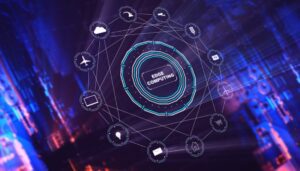Edge technology as a modern industry sprung up as a result of the shift of processing from cloud to edge. Cloud gaming services is booming as a result of the need of more low latency benefits for the end users.
As the gadgets interconnected to the internet grows and their possibilities improve, so too does the demand for real making decisions free of cloud computing’s delay and, sometimes in circumstances, connection. Edge technology is a modern industry that has sprung up as a result of the shift of processing resources from the cloud to the edge. Edge computing gives proper local machine learning to gadgets without the need to contact the cloud to make conclusions. IoT gadgets function under settings that vary from some of those found in corporate offices, necessitating the establishment of a new range of components to enable processing in such locations. The expanding usage of cloud-based AI techniques like machine learning techniques is pushing developments in hardware designs that can keep up with the applications’ voracious need for computing power and storage capacity (Gan et al., 2019). Without developments in technology, technologies such as instant-booting PCs, cell phones, jaw-dropping video game graphics, lightning-fast in-memory analytics, and hugely spacious memory devices would be significantly more restricted or prohibitively costly.

Edge Computing
Edge computing is a decentralized IT framework inside which customer data is analysed as near to the original point as feasible at the platform’s perimeter. Edge computing relocates certain memory and computation capabilities away from the main data centre and nearer to the raw data. Instead of sending unprocessed information to a data centre for analysis and interpretation, this process is carried in which the information is captured, whether in a retail outlet, a manufacturing floor, a large utility, or throughout a smart city (Coppolino et al., 2019). IT and corporate computing are being reshaped by edge computing.
Edge computing Hardware?

The structural characteristics and capabilities required to operate a program at the edge are referred to as edge computing hardware. Centres, CPUs, networking devices, and endpoint devices are among these technologies (Capra et al., 2019). Edge Ecosystem Analyzer is used to learn about additional aspects of the edge value chain.
Impact of Edge Computing on Hardware for Cloud Gaming
Edge computing has a wide range of functions that work in a variety of circumstances and environments. Dependent on various application scenarios and sectors, they have various hardware needs. It’s no coincidence that several businesses are moving to the edge as connection improves and the development of low-delay “real-time” data processing grows. With this change, nevertheless, there seems to be a significant necessity for edge computing gear to be created for unique circumstances for its many business applications, each with its own set of hardware specifications (Satyanarayanan et al., 2021). For instance, in automated vehicles, ultimate decision-making is required for movement control, therefore increased hardware is a requirement owing to the massive volumes of data being analysed in real-time; but, thanks to the car’s limited space, equipment design is indeed a limitation.
Gaming on the Edge ( and Cloud)
The majority of game computation is now performed on gadgets directly. Although some computing may be performed on a remote server — where a gadget can transmit information to be analyzed and then delivered into these systems is often located far away in enormous data centres, which implies the time it would take for data to be delivered will eventually diminish the gaming performance. Rather than a single huge remote server, mobile edge computing depends on multiple small distribution centres that are located in a nearer close presence (Braun et al., 2017). So because gadgets won’t just have to transfer information to a data computer, analyze it, and afterwards deliver the data, MEC can preserve computing power on gadgets for a smoother, quicker gameplay experience.
Cloud computing
Something that includes offering distributed services via the internet is referred to as cloud computing. IaaS, PaaS, and SaaS are the three basic forms of cloud computing technology. It is possible to have a business or government cloud. Everyone on the internet may buy services from a cloud platform (Younas et al., 2018). A private cloud is a closed network or data centre that provides a platform as a service to a small group of individuals with policy actions and privileges. The purpose of cloud computing, whether business or government, is to give quick, flexible access to network infrastructure and IT applications.
Cloud infrastructure and hardware
Cloud infrastructure is a word that refers to the hardware, abstract services, memory, and networking capacity that are required for cloud computing. Consider cloud infrastructure to be the technologies required to create a cloud. Cloud infrastructure is required to operate operations and services in the cloud.
Cloud Gaming
Cloud gaming refers to the practice of playing games on servers located remotely in cloud services. On either a PC or smartphone, so no need to acquire and download games. Rather, to deliver game data to an application or website loaded on the target device, streaming sites create a steady internet service. The action is generated and performed on a distant server, yet everything here is seen and interacted with directly on the devices. Throughout most situations, cloud computing gaming involves an annual or monthly membership to obtain the game. Some applications need the acquisition of games in addition to the charge (Choy et al., 2014). Customized or internet apps are frequently given by cloud gaming solutions to stream sports.
Conclusion
The role of the network is changing when it comes to offering exceptional experiences with these new interactions. The growing use of cloud-based AI techniques such as machine learning is driving hardware innovations that can keep up with the applications’ insatiable need for computational power and storage space. Edge computing encompasses a wide range of capabilities that may be used in some situations and contexts (Gan et al., 2019). Cloud gaming is booming, due in part to the global coronavirus outbreak and broad implementation of shelter-in-place rules. Gaming is a tremendous technical platform that can be applied to a wide range of sectors, including Edge, Cloud and Hardware.
Read More about Edge Gaming






